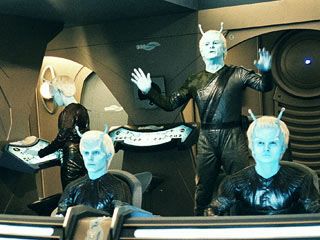Creativity
Creativity and Star Trek Alien Foreheads
What does psychology say about alien design for television?
Posted May 13, 2013

Andorians from Star Trek
Looking at televised science fiction and fantasy you would be forgiven for thinking that the designers lacked imagination. I've heard Star Trek criticized for having each alien race differ only in forehead and ear shape. Pictured are the "Andorians" from Star Trek. Note that they basically look like humans, with a change in color, the addition of antennae, and, of course, a wrinkly forehead.
Creative readers might ask: Why don't the aliens look completely different from anything on Earth? Woudn't that be more interesting? Wouldn't that be more realistic?
There are two broad reasons aliens on television and film look so human.
Reason One: Budgetary Constraints
Television shows have limited budgets. Actors are cheaper than puppets, and are probably still cheaper than full computer graphic generated characters. As such, it's cheaper to costume a person than to feature an alien that has no physical resemblence to a person.
This explains a bit, such as why they tend to have two legs and two arms, but leaves some questions unanswered: why the forehead and not the mouth? Why the ears but not the eyes?
Reason Two: We Relate to Humanoid Aliens Better
There are indeed non-humanoid aliens in science fiction. The real problem is that they are harder to relate to in narratives, which need characters we understand. We naturally understand the meaning of a smile, the sound of a voice raised in anger, and a lot of other expressions. A real intelligent alien would probably express things in a completely unrecognizable way--that would be realistic. But it makes the essential drama of the narrative more difficult to appreciate.
Many of us understand some things about how dogs communicate: many of us know that the tail wagging of a dog functions similarly to a smile. But in general our understanding of non-mammalian communication is pretty weak.
Humanlike aliens are more compelling, more interesting. It is probably related to the fact that characters in fiction are almost universally psychologically realistic. That is, we can use our folk understandings of how people think to understand them: they have knowledge, desires, and personalitites. This is true as true for Mr. Spock as C-3P0.
Hiding the face with a mask removes communication using facial expression. Covering the eyes and mouth, in particular, would make it hard for the audience to understand the alien's mindstate. As a result, the things that get commonly changed for TV aliens are those things that won't interfere with facial expression- foreheads, hair, color, ears, and noses, as opposed to eyes and mouths.
The budget constrains good TV aliens, but so does your own psychology and ability to appreciate characters in stories.
A Note about the photo: This image is a screenshot of a copyrighted television program or station ID. As such, the copyright for it is most likely owned by the company or corporation that produced it. It is believed that the use of a limited number of web-resolution screenshots for identification and critical commentary on the station ID or program and its contents qualifies as fair use under United States copyright law. Any other uses of this image, on Wikipedia or elsewhere, might be copyright infringement. For more information, seeWikipedia:Non-free content.


